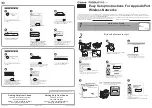
Software User Manual
D-Link Unified Access System
02/15/2011
Document 34CS3000-SWUM104-D10
Page 91
Use the buttons at the bottom of the page to perform the following tasks:
•
Click
Clear
to reset the page to the default values.
•
Click
Refresh
to update the screen with the most current information.
•
After you change the wireless network settings, click
Submit
to save the changes.
•
Because
Client QoS Bandwidth Limit Down
and
the Client QoS Bandwidth Limit Up
have to be set to n*64000 bits/
sec (n = 0, 1, 2, ...), click the
Round Down
Rates
button to:
-
Round down the values to the nearest multiple of 64000 bits/sec if the value entered is greater than 64000 bits/sec.
-
Round up to 64000 bits/sec if the value entered is less than 64000 bits/sec.
Another way to navigate to the
Wireless Network Configuration
page:
1
Click
WLAN > Administration > Advanced Configuration > Networks
to display the
Wireless Network Summary
page
2
Click any network SSID to navigate to the
Wireless Network Configuration
page.
Client QoS
The Client QoS parameters allow the switch to apply access control lists (ACLs) and
differentiated service (DiffServ) policies to wireless clients associated to the AP and extend
the switch QoS features into the wireless domain.
Select this option to enable Client QoS operation for wireless clients that associate with the
AP using the SSID in the previous field.
Client QoS provides control over certain QoS aspects of wireless clients that connect to the
network, such as the amount of bandwidth and type of traffic an individual client is allowed to
send and receive. To control general categories of traffic, such as HTTP traffic or traffic from
a specific subnet, you can configure ACLs and assign them to one or more VAPs. Client QoS
also allows you to configure per-client conditioning of various micro-flows through DiffServ.
ACLs are a collection of permit and deny conditions, called rules, that provide security by
blocking unauthorized users and allowing authorized users to access specific resources.
ACLs can block any unwarranted attempts to reach network resources.
Each ACL is a set of up to ten rules applied to traffic sent from a wireless client or to be
received by a wireless client. Each rule specifies whether the contents of a given field should
be used to permit or deny the packet from being transmitted. Rules can be based on various
criteria and may apply to one ore more fields within a packet, such as the source or destination
IP address, the source or destination L4 port, or the protocol carried in the packet.
DiffServ policies are a useful tool for establishing general micro-flow definition and treatment
characteristics that can be applied to each wireless client, both inbound and outbound, when
it is authenticated on the network. Packets are classified and processed based on defined
criteria. The classification criteria is defined by a class. The processing is defined by a policy's
attributes.
Client QoS Bandwidth
Limit Down (bits-per-
second)
Enter the maximum allowed transmission rate from the AP to the wireless client in bits per
second. The valid range is 0-4294967295 bps. A value of 0 means that the bandwidth
maximum limit is not enforced in this direction.
Note:
Client QoS is only supported when DWL-8600AP is managed by a DWS-3000 switch.
Client QoS Bandwidth
Limit Up (bits-per-
second)
Enter the maximum allowed client transmission rate to the AP in bits per second. The valid
range is 0-4294967295 bps. A value of 0 means that the bandwidth maximum limit is not
enforced in this direction.
Table 14: Wireless Network Configuration
Field
Description
















































